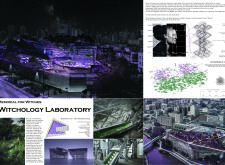5 key facts about this project
The "Memorial for Witches" serves as both a memorial and an educational facility focused on the history and significance of witchcraft. It highlights the role of witches as healers and guardians within their communities. The design emphasizes a connection between nature and education, featuring a layout that supports herb cultivation and promotes understanding of the environmental conditions necessary for plant growth.
Conceptual Framework
The design centers on the relationship between herbs and their environments. The spaces within the building include counseling and assembly rooms, which facilitate learning and echo the historical functions of witches as herbalists and midwives. By integrating these elements, the project invites visitors to engage with the narratives surrounding witchcraft in a thoughtful way.
Herb Distribution and Spatial Organization
A key aspect of the project is the roof flower bed, which includes an herb distribution map organizing various plants by their specific growing needs. For instance, herbs such as garlic, pepper, thyme, rosemary, and sage thrive in full sunlight and dry soil. Other herbs like oregano, basil, and chamomile prefer medium shadow and humidity, while coriander, ginger, and mint flourish in wetter conditions. This careful categorization reflects a well-planned approach to herb cultivation.
Environmental Context and Community Engagement
Historical narratives are essential to the project's identity. It provides a contemporary view that repositions witches within society. By addressing the diverse roles witches have played throughout history—from shamans to herbal practitioners—the design fosters a greater appreciation for these figures. The arrangement of distinct zones tailored to different herbs enhances the visitor experience, encouraging exploration and interaction with the space.
Design Details
The layout of the memorial showcases a commitment to sustainability and ecological understanding. Education and environmental awareness are interwoven throughout the experience. The interplay of light and shadow over the herb beds brings attention to seasonal changes, offering an engaging experience that underscores themes of growth and healing. The overall design communicates a sense of purpose, inviting reflection on the historical significance of witchcraft while connecting it to present-day practices.



















































